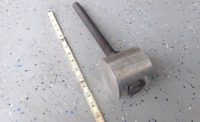
The safety industry in recent years — in both industry publications and in the workplace itself — has experienced a barrage of thin-gauged gloves that offer high levels of dexterity and comfort. These styles have helped to persuade employees who traditionally have been bare-handed or non-glove users to wear gloves. While this is a positive development for specific applications or in certain work areas, there are growing concerns about a potential increase in injury problems.
Billed as very thin and cut-resistant, many of these thin-gauged gloves have only 400-600 grams of cut resistance, which is the equivalent of a standard cotton or terry glove. In terms of puncture resistance, because these gloves are so thin they have given up even the basic level of protection provided by leather or thicker dipped or coated gloves.
Comfort vs. safety?
Safety and plant managers have expressed a concern that thin-gauged, low to medium 1-3 ISEA cut-level gloves have migrated to work areas where higher cut, puncture and abrasion resistance is needed. Employees falsely view such gloves as their cut-resistant gloves in production. This is causing their usage to increase and, more importantly, an escalation of first-aids and OSHA-recordable injuries.An additional variable is the proliferation of SKUs in plants that have battled over the years to narrow the hand protection styles down. The plant managers, safety and procurement group then state that they are caught in a battle of comfort versus safety. Typically, once an employee wears the thin, comfortable gloves it is very difficult to test and get employee approvals for a heavier product with 25-75 percent more protection from the hazards. A common response heard in nurses’ offices or in post-injury investigations is, “I was wearing my cut-resistant gloves when the injury occurred.†One plant manager recently summed it up when he said, “You know, we have done ourselves a great disservice without even knowing it. We bought the thin-gauge gloves for our assembly areas, and now they are in other production areas. Guess what, level 3 cut resistance doesn’t mean anything in those areas… and now I have to convince them to go back to a heavier glove… that won’t be easy!â€
New wave
As technology continues to improve, the gap between hand protection viewed as having a high level of dexterity and comfort versus hand protection that offers the necessary amount of puncture and cut protection has narrowed. There is a new wave of products and alternative technologies that offer a unique combination of cut resistance and puncture resistance. This combination traditionally has been solved by offering two different styles that in the past have added up to six additional SKUs. Solving the puncture problem industrially has also been very difficult in the past.The glass industry, for example, has historically faced these same issues. Glass plants have looked to add glove styles that offer a combination of dexterity, comfort and grip as well as cut and puncture resistance. The solution that has been most commonly implemented is a two-glove approach with an outer glove providing grip and an inner glove for cut and puncture resistance. The thin-gauge gloves have in some cases been implemented with unfortunate trends resulting in an increase in injuries, some of which can be severe. Technological advances have now significantly increased the level of puncture and cut resistance with a good level of dexterity and comfort — not quite to the level of the fine-gauge products, but enough to meet the comfort needs of users and, most importantly, to provide the right protection for the application.
Right balance
In conclusion, although thin-gauged glove products that have a high level of comfort help in employee adherence in regards to hand protection, meeting that right balance of comfort, cut and puncture resistance in the end may eliminate headaches — and hand injuries — and, moreover, help companies meet their safety objectives.Sidebar: Put gloves to the test
- ASTM 1342 — Standard test against punctures from nails.
- ASTM F 1790 — Standard test against cut resistance from razor blades.
- ISEA - International Safety Equipment Association — The standards for cut-resistance testing are broken into different levels of safety, with Level I as the weakest level and Level V as the highest level of cut protection.
Mike Gompers, QSSP, manages the eastern U.S. sales territories and works in product development for HexArmor®, which makes industrial safety products for cut and puncture protection. He is a graduate of Robert Morris College. Mike can be reached at (724) 825-0376 or mike@hexarmor.com.
Todd Winters is the midwest sales manager for HexArmor©. He is a graduate of Missouri State University. Todd can be reached at (816) 830-3606 or todd@hexarmor.com.

